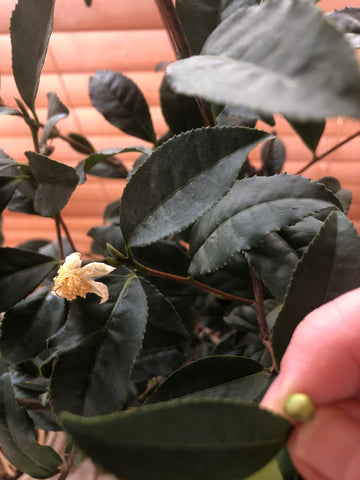
My tea plants are still with me! I have managed to keep them alive for 1 whole month. My record is actually 14 months of keeping tea plant saplings alive; but who's counting? I have decided to keep them in the original pots that they came in, and have kept them in a west facing window since their arrival.
Left Alone, Undisturbed
I thought about repotting the tea plants when they first arrived. I had all the nessessities; potting, soil, pots, wood chips. Then I started over - thinking through the whole plan. What if I have the wrong pots? Are clay pots too much of a moisture retainer? Should I put rocks in the bottom of the pots to aid in drainage and to help keep the feet of the plant (the roots) dry? What if I have the wrong soil (even though I researched on line which soil to use)? What if I make a mistake and cause the plants to die?
I just know this year will be different. I feel I can do it, I can make a success of growing the tea plants. I am going to do things differently this time. I decided to make a call to someone who can help me get to the root of the problem regarding growing tea plants.
The Call
I made a call to the County Garden Extension and spoke to a Master Gardener. I explained that I have tea plants and seeds that are artificially placed in a cold refrigerator for stratification. I explained that my intention is to keep the tea plants in pots until it is time to plant them. He asked me what specific genus and species they were in, and what size they were. He stated that he would need to call me back, that he would have to research growing the Camellia Sinensis Sinensis. An honest answer. I can appreciate not knowing an answer to every question ever asked. It takes honesty, and wisdom to say “I’ll get back with you with an answer”.
Returned Call

The Master Gardener called me back the next day. He explained that he looked at Missouri Botanical Garden’s website. He also encouraged me to look at the website. He then proceeded to answer the questions I had asked of him a day earlier. Following is an excerpt from that conversation.
The Checkup or Tending to Needs
I ended the conversation with a renewed sense of hope. I gained some valuable information and encouragement in talking to the master gardener, and looking on the website he recommended. I really believe this year will be a good year for growing tea plants. However, I have an urgent matter that I need to attend to regarding the large tea plant.
One thing I do know concretely about tea plants is that they are not allowed to produce blooms in tea gardens. The flowers take much needed energy and precious resources from the plant. The blooms can adversely affect the growth of the plant itself.
My large tea plant has several blooms and a few flower buds. To me, this was an urgent matter. I needed to get the flower buds and the few spent blooms off the plant so that all energy can go into producing bud and leaf sets. I pinched the flower buds and the flowers off the plant immediately. One chore completed, more to go.
My tasks for this month are piling up. I am a list writer. I find that lists help me stay focused on what needs to be done. I don’t feel so overwhelmed by bombarding thoughts of “don't forget…” when I make a list. When I write my task, or thought down, it frees up my mind to think about other things. Finally, a list gives me a sense of accomplishment when I cross off a completed item on my list.
My task list for this month include:
- Order the correct type of potting soil, peat moss and small pots for planting the seeds. 2. Look on line to find out what recyclable material would work well for seedling pots. I need to make sure that the drainage is adequate for the seeds.
- Start a compost pile immediately. It will need to be a small countertop compost container so that Louie The Dog won’t be able to eat out of it. The compost is only as good as the dog not eating it!
- Research the recommended website for growing tips.
- Look in the yard for a possible site for a raised bed to grow the seeds. The raised bed needs to have high sides so that Louie The Dog does not eat the leaves off the sprouted seeds.
- Possibly make or purchase a small greenhouse that can be used inside or outside for the seeds.
- Re-pot the existing tea plants into larger pots.
Daunting But Determined

I could feel daunted about growing the tea plants and my list of things to do. Instead, I am choosing to be determined. I can and will grow tea plants! This is a new year, and a wiser me. I have much to learn and several people who will encourage me along my tea plant journey. My mantra for this year will be “I know I can grow tea plants with learning and the help of others.”
Now if I can just keep Louie The Dog out of the tea plants………
Leslie
About the Author
Leslie Sundberg is a World Tea Academy Certified Tea Specialist, a World Tea Academy Apprentice Tea Sommelier, a Specialty Tea Institute Level IV trained Tea Specialist, and a Tea and Business Etiquette Specialist. On any given day, Leslie can be found teaching, speaking or sharing in the joys of a cup of tea. No matter what Leslie is doing or where she is, one thing remains constant: 4:00 in the afternoon is tea time!
